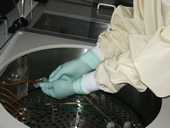Glutaraldehyde

Overview
Glutaraldehyde is a colorless, oily, liquid-chemical with a pungent odor. It is used for a number of applications such as the following:
- A cold sterilant in the health care industry
- A cross-linking and tanning agent
- A biocide in metalworking fluids and in oil and gas pipelines
- An antimicrobial in water-treatment systems
- A slimicide in paper manufacturing
- A preservative in cosmetics
- A disinfectant in animal housing
- A tissue fixative in histology and pathology labs
- A hardening agent in the development of X-rays
- In embalming solutions
- In the preparation of grafts and bioprostheses
- In various clinical applications
In the health care industry, glutaraldehyde is most often used to disinfect equipment that cannot be heat sterilized such as dialysis instruments, surgical instruments, suction bottles, bronchoscopes, endoscopes, and ear, nose, and throat instruments.
The chemical is most often used in a diluted form with solutions ranging from 0.1% to 50% glutaraldehyde in water. Trade names for glutaraldehyde-containing formulations include Cidex®, Sonacide®, Sporicidin®, Hospex®, Omnicide®, Metricide®, Rapicide® and Wavicide®.
Workers can be exposed to glutaraldehyde through inhalation or skin contact. Health effects that may occur as a result of exposure to glutaraldehyde include but are not limited to the following:
- Throat and lung irritation
- Asthma and difficulty breathing
- Contact and/or allergic dermatitis
- Nasal irritation
- Sneezing
- Wheezing
- Burning eyes and conjunctivitis
NIOSH Resources
NIOSH Glutaraldehyde: Occupational Hazards in Hospitals
DHHS (NIOSH) Publication No. 2001-115
Provides information about the adverse health effects of glutaraldehyde, describes how hospital workers can be exposed to glutaraldehyde, and identifies control methods and work practices to prevent or reduce exposure.
En Español
NIOSH Pocket Guide to Chemical Hazards
Key data provided for each chemical/substance includes name, structure/formula, CAS/RTECS Numbers, DOT ID, conversion factors, exposure limits, IDLH, chemical and physical properties, measurement methods, personal protection, respirator recommendations, symptoms, and first aid.
International Chemical Safety Cards (ICSC)
Essential health and safety information about chemicals for their use at the "shop floor" level by workers and employers in factories, agriculture, construction, and other work places.
- Glutaraldehyde (1,5-Pentanedial, Glutaric dialdehyde, Glutaral)
- Glutaraldehyde (50% solution), (1,5-Pentanedial 50% solution)
NIOSH Manual of Analytical Methods (NMAM)
Collection of methods for sampling and analysis of contaminants in workplace air and in the blood and urine of workers who are occupationally exposed.
- Glutaraldehyde (No. 2532) [PDF - 25 KB]
- Aldehydes, screening (No. 2539) [PDF - 255 KB]
NIOSH Current Intelligence Bulletin 55: Carcinogenicity of Acetaldehyde and Malonaldehyde, and Mutagenicity of Related Low-Molecular-Weight Aldehydes
DHHS (NIOSH) Publication No. 91-112
Information about the potential carcinogenicity and mutagenicity of acetaldehyde and malonaldehyde, the chemical reactivity and mutagenicity of nine related aldehydes, and includes guidelines for minimizing occupational exposures.
NIOSH Registry of Toxic Effects of Chemical Substances (RTECS): Glutaraldehyde
Includes detailed information about toxic health effects and official exposure recommendations and standards for glutaraldehyde.
Selected Journal and Abstract Citations
The following are selected journal articles about glutaraldehyde with NIOSH co-authors:
Vo E, Zhuang Z. [2009]. The use of aldehyde indicators to determine glutaraldehyde and alkaline glutaraldehyde contamination in chemical protective gloves . Arch Environ Contam Toxicol Jul; 57(1): 185-192.
Dankovic DA, Bailer A. [2007]. A glutaraldehyde risk assessment using benchmark doses: decisions, decisions, decisions! Toxicologist, Mar; 96(1): 336.
Vo E, Murray DK, Scott TL, Attar AJ. [2007]. Development of a novel colorimetric indicator pad for detecting aldehydes . Talanta, 2007 Aug; 73(1): 87-94.
Azadi S, Butterworth LF, Meade BJ. [2004]. Divergent immunological responses following glutaraldehyde exposure . Toxicol Appl Pharmacol, May; 197(1): 1-8.
Vo E. [2002]. Development of colorimetric indicators: a new technique to determine glutaraldehyde and alkaline glutaraldehyde contamination . Proceedings of the International Conference on Occupational and Environmental Exposures of Skin to Chemicals: Science & Policy, Arlington, VA, September 8-11. Morgantown, WV: National Institute for Occupational Safety and Health. Sep; 5.
NIOSH Health Hazard Evaluations
HHE Report No. HETA-2003-0205-3032 , Interfaith Medical Center, Brooklyn, New York
HHE Report No. HETA-90-296-2149 , Monongalia General Hospital, Morgantown, West Virginia
HHE Report No. HETA-86-226-1769 , Montgomery Hospital, Norristown, Pennsylvania
HHE Report No. HETA-85-257-1791 , Mercy Medical Center, Denver, Colorado
HHE Report No. HETA-84-535-1690 , National Jewish Hospital, Denver, Colorado
NIOSHTIC-2
NIOSHTIC-2 is a searchable bibliographic database of occupational safety and health publications, documents, grant reports, and journal articles supported by NIOSH.
NIOSHTIC-2 search results on Glutaraldehyde
Other U.S. Government Resources
Occupational Safety and Health Administration (OSHA) Best Practices for the Safe Use of Glutaraldehyde in Health Care
Information to be used by health care employers and employees to understand and control exposures.
OSHA Hospital eTool: Glutaraldehyde
Identifies possible employee exposure to glutaraldehyde in the workplace and provides possible solutions.
EPA: Reducing Ethylene Oxide and Glutaraldehyde Use [PDF - 362.50 KB]
U.S. Food and Drug Administration (FDA) Device Evaluation Information: FDA-Cleared Sterilants and High Level Disinfectants with General Claims for Processing Reusable Medical and Dental Devices
This chart provides information about several manufactured sterilants and high-level disinfectants including chemical trade names, active ingredients, sterilant contact conditions, and high level disinfectant contact conditions as recommended by the FDA.
Additional Resources
American Federation of Government Employees: Glutaraldehyde Information
California Department of Public Health: Glutaraldehyde Fact Sheet [PDF - 55 KB]
DOW Microbial Control Resource Center
Available in English, German, Spanish, Portuguese, Chinese and Japanese.
New Jersey Hazardous Substance Fact Sheets: Glutaraldehyde [PDF - 71 KB]
New Jersey: Guidelines for Safe Use of Glutaraldehyde in Health Care Facilities [PDF - 77.13 KB]
New Zealand: The Safe Occupational Use of Glutaraldehyde in the Health Industries [PDF - 88 KB]
Organization for Economic Cooperation and Development (OECD) Screening Information Data Sets (SIDS): Glutaraldehyde [PDF - 313.49 KB]
- Page last reviewed: March 3, 2012
- Page last updated: March 3, 2012
- Content source:
- National Institute for Occupational Safety and Health Education and Information Division


 ShareCompartir
ShareCompartir